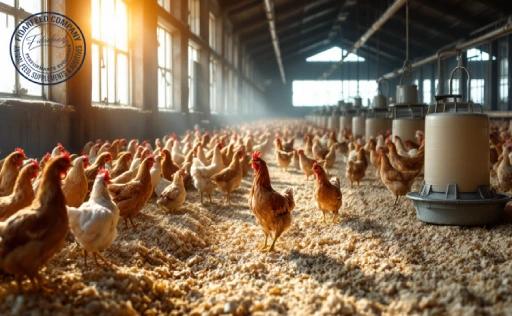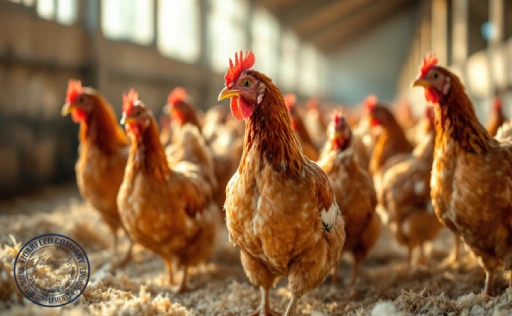How Lighting Affects Egg Production and Quality is not just a question of turning the lights on and off. It’s about understanding how light—its duration, intensity, and even its color—can influence the biology and productivity of laying hens. For poultry farmers, especially those raising layers for eggs, lighting plays a vital role in managing the health of their flock and ensuring consistent, high-quality egg production. Whether you’re an experienced poultry breeder or just starting out, understanding lighting can lead to real improvements in flock performance. Let’s dive into how light shapes egg quality and what practical steps you can take to make the most of it on your farm.
Why Lighting Matters in Poultry Farming: The Science Behind Egg Production
Hens are highly sensitive to changes in light. Light exposure affects their pineal gland and hypothalamus, which regulate melatonin and reproductive hormones like luteinizing hormone (LH). These hormones control ovulation and egg-laying cycles.
Learn more about: http://product
Simply put, light tells the bird’s body: “It’s time to lay an egg.” Without sufficient or appropriate lighting, hens can go out of lay, produce fewer eggs, or stop laying entirely. This is why lighting is not a background concern—it’s a major lever of productivity
How Lighting Affects Egg Production and Quality: A Closer Look
Studies show that light influences:
-
Egg quantity: Poor lighting decreases laying frequency.
-
Egg quality: Shell strength, yolk color, and albumen thickness are all affected.
-
Bird health: Inconsistent lighting increases stress and lowers immune resistance.
Learn more about: Boost Your Egg Production with Classica Layer Chickens
Controlled lighting supports not just more eggs, but better eggs. This matters both for market value and for maintaining flock health over longer production cycles.
Finding the Right Light Duration for Optimal Laying Cycles
Light duration—also known as photoperiod—is one of the most important factors in poultry lighting.
-
Young layers need at least 14 to 16 hours of light per day to maintain egg production.
-
Anything below 12 hours typically causes hens to enter molt or cease laying.
-
Too much light (over 17 hours) can overstimulate and exhaust birds over time.
Farmers often use timers to simulate longer days during winter or to standardize lighting in enclosed environments. Gradual increases (not abrupt changes) in day length are best to stimulate laying naturally.
Light Intensity: How Brightness Levels Influence Layer Performance
Light intensity is measured in lux. Layers typically require:
-
10 to 20 lux at bird level for ideal egg production.
-
Below 5 lux, hens may not respond to light stimulation.
-
Above 50 lux, birds may become stressed or aggressive.
Learn more about: Decreased Egg Production in Laying Hens: Common Diseases in Chickens to Watch
Bright lighting doesn’t mean better results—it’s about finding the sweet spot. In barns, using evenly spaced bulbs and avoiding dark corners helps ensure uniform exposure.
The Impact of Light Color on Egg Size, Shell Strength, and Yolk Quality
Different wavelengths of light affect bird behavior and physiology in unique ways:
-
Red light enhances reproductive activity and has been shown to improve egg production and size.
-
Blue or green light tends to have a calming effect, but may delay sexual maturity if used alone.
-
Natural white light provides a balanced spectrum and is often used to mimic daylight.
Learn more about: The Chicken Egg Production Cycle: A Comprehensive Overview
A study published in Poultry Science Journal found that hens exposed to red-spectrum LED light produced eggs with thicker shells and better yolk color, compared to those under traditional white bulbs.
Natural Light vs. Artificial Light: Which One Is Best for Your Flock?
Natural light is ideal in open-range or well-ventilated coops, but it’s not always consistent—especially during shorter winter days. That’s where artificial lighting steps in.
Natural light:
-
Economical
-
Seasonal variability
-
Harder to control
Learn more about: Probiotics’ Effect on Egg Production: Boosting Naturally
Artificial light:
-
Precise control over duration and intensity
-
More consistent production year-round
-
Higher setup and energy costs
The most successful farms often use a hybrid system, maximizing natural light while supplementing it as needed to maintain productivity.
Seasonal Changes and Their Effect on Lighting and Egg Production
As daylight hours shorten in fall and winter, hens naturally reduce egg production unless artificial light compensates.
To prevent production drops:
-
Slowly increase light duration by 15–30 minutes per week as days shorten.
-
Maintain a consistent photoperiod of 14–16 hours daily using artificial lighting.
-
Monitor temperature and humidity, as these also fluctuate with seasons and can impact laying.
Planning ahead for seasonal transitions keeps your flock laying steadily year-round.
Practical Tips for Setting Up a Lighting Schedule That Boosts Egg Quality
Creating a lighting schedule doesn’t have to be complex. Start with these basics:
-
Use timers to automate on/off cycles.
-
Avoid abrupt shifts in lighting—gradual transitions reduce bird stress.
-
Provide a dawn and dusk effect using dimmers or staggered lights.
-
Clean light fixtures regularly to maintain proper lux levels.
-
Regularly check for bulb failure or uneven distribution.
Learn more about: How To Start Egg Laying Chicken Business: Your First Steps
Consistency is key. Irregular lighting confuses birds and leads to missed laying opportunities.
Common Lighting Mistakes That Hurt Egg Production—and How to Avoid Them
Many poultry farmers unknowingly make lighting errors that affect their output. Watch out for:
-
Sudden changes in lighting duration or intensity
-
Inconsistent daily schedules
-
Uneven light distribution in housing
-
Using the wrong light spectrum
-
Skipping lighting altogether during shorter days
These missteps can lead to poor egg quality, reduced fertility, and even behavioral problems like pecking or cannibalism. Simple adjustments can prevent serious losses.
Integrating Lighting with Nutrition and Housing for Maximum Egg Quality
Lighting doesn’t work in isolation. To get the best results:
-
Ensure birds receive balanced feed, rich in calcium, vitamins A, D3, and E.
-
Maintain proper ventilation and temperature control in housing.
-
Combine lighting strategies with regular flock health checks.
-
Use lighting changes to support key flock events like molting, breeding, and peak production cycles.
Learn more about: How Stocking Density Affects Chicken Health and Egg Laying
By aligning nutrition, lighting, and housing, poultry farmers can unlock the full genetic potential of their flocks and consistently produce high-quality eggs.
Conclusion
Understanding how lighting affects egg production and quality is one of the smartest moves a poultry farmer can make. It’s not just about flipping a switch—it’s about managing biological rhythms, improving welfare, and driving consistent results.
Whether you’re fine-tuning your current system or setting up a new one, remember that light influences everything from hormone levels to yolk color. With thoughtful planning, the right setup, and attention to detail, you can boost both productivity and profitability.
Do you have experience with lighting in your poultry house? Have questions about optimizing your setup? Share your thoughts, ask questions, or leave a comment below—we’d love to hear from you!









